Electromagnetic Waves MCQs
NEET Physics For Electromagnetic WavesMultiple Choice Questions
Question 1. A capacitor of capacitance ‘C’ is connected across an ac source of voltage V, is given by \(\mathrm{V}=\mathrm{V}_0 \sin \omega \mathrm{t}\). The displacement current between the plates of the capacitor would then be given by :
- \(\mathrm{I}_d=\mathrm{V}_0 \omega C \sin \omega \mathrm{t}\)
- \(\mathrm{I}_d=\mathrm{V}_0 \omega C \cos \omega \mathrm{t}\)
- \(\mathrm{I}_d=\frac{\mathrm{V}_0}{\omega c} \cos \omega \mathrm{t}\)
- \(\mathrm{I}_d=\frac{\mathrm{V}_0}{\omega c} \sin \omega \mathrm{t}\)
Answer: 2. \(\mathrm{I}_d=\mathrm{V}_0 \omega C \cos \omega \mathrm{t}\)
Given
A capacitor of capacitance ‘C’ is connected across an ac source of voltage V, is given by \(\mathrm{V}=\mathrm{V}_0 \sin \omega \mathrm{t}\).
Displacement Current, \(\mathrm{I}_d =\frac{C d V}{d t} \)
⇒ \(\mathrm{I}_d =C \frac{d}{d t}\left(V_0 \sin \omega \mathrm{t}\right) \)
∴ \(\mathrm{I}_d =C V_0 \omega \cos \omega \mathrm{t}\)
Question 2. For a plane electromagnetic wave propagating in the x-direction, which one of the following combinations gives the correct possible directions for the electric field (E) and magnetic field respectively?
- \(\hat{j}+\hat{k}, \hat{j}+\hat{k}\)
- –\(\hat{j}+\hat{k},-\hat{j}-\hat{k}\)
- \(\hat{j}+\hat{k},-\hat{j}-\hat{k}\)
- –\(\hat{j}+\hat{k},-\hat{j}+\hat{k}\)
Answer: 2. –\(\hat{j}+\hat{k},-\hat{j}-\hat{k}\)
For a plane EM wave the E and B field are mutually perpendicular. Hence (1), (3) and (4) are not possible.
Electromagnetic Waves MCQs
Question 3. The magnetic field in a plane electromagnetic wave is given by: \(\mathrm{B}_y=2 \times 10^{-7} \sin \left(\pi \times 10^3 x+3 \pi \times 10^{11}\right)\). Calculate the wavelength.
- \(\pi \times 10^3 \mathrm{~m}\)
- 2 \(\times 10^{-3} \mathrm{~m}\)
- 2 \(\times 10^3 \mathrm{~m}\)
- \(\pi \times 10^{-3} \mathrm{~m}\)
Answer: 2. 2 \(\times 10^{-3} \mathrm{~m}\)
Given
The magnetic field in a plane electromagnetic wave is\( \mathrm{B}_y=\mathrm{B}_{\mathrm{o}} \sin (k x-\omega t)\) → Equation 1
The given magnetic field in a plane electromagnetic wave is,
⇒ \(\mathrm{B}_y=2 \times 10^{-7} \sin \left(\pi \times 10^3 x+3 \pi \times 10^{11} t\right)\) → Equation 2
comparing eq. (1) and eq. (2) we get,
k= \(\pi \times 10^3\)
⇒ \(\frac{2 \pi}{\lambda} =\pi \times 10^3 \)
⇒ \(\lambda =\frac{2}{10^3} \)
= 2 \(\times 10^{-3} \mathrm{~m}\) .
Read and Learn More NEET Physics MCQs
Question 4. The ratio of the contribution made by the electric field and magnetic field components, to the intensity of an electromagnetic wave, is (where, c = speed of electromagnetic waves):
- 1: 1
- 1: c
- 1: c²
- c: 1
Answer: 1. 1: 1
We know that, \(\frac{E_0}{B_0}\)=c
Where, \(E_0\)= Peak values of electric field
⇒ \(B_0\)= Peak value of magnetic field
Then \(E_0: B_0\)=1: 1.
Electromagnetic Waves MCQs
Question 5. For a transparent medium relative permeability and permittivity \(\mu_r\) and \(\varepsilon_r\) are 1.0 and 1.44 respectively. The velocity of light in this medium would be :
- 2.5 \(\times 10^8 \mathrm{~m} / \mathrm{s}\)
- 3 \(\times 10^8 \mathrm{~m} / \mathrm{s}\)
- 2.08 \(\times 10^8 \mathrm{~m} / \mathrm{s}\)
- 4.32 \(\times 10^8 \mathrm{~m} / \mathrm{s}\)
Answer: 1. 2.5 \(\times 10^8 \mathrm{~m} / \mathrm{s}\)
The velocity of light in a medium is,
v= \(\frac{c}{\sqrt{\mu, \varepsilon_r}}\)
v= \(\frac{3 \times 10^8}{\sqrt{1 \times 1.44}} \)
v= 2.5 \(\times 10^8 \mathrm{~ms}^{-1}\)
Question 6. In an electromagnetic wave in free space, the root mean square value of the electric field in Ems = 6 V/m. The peak value of the magnetic field is :
- \(1.41 \times 10^{-8} \mathrm{~T}\)
- 2.83 \(\times 10^{-8} \mathrm{~T}\)
- 0.70 \(\times 10^{-8} \mathrm{~T}\)
- 4.23 \(\times 10^{-8} \mathrm{~T}\)
Answer: 2. 2.83 \(\times 10^{-8} \mathrm{~T}\)
According to the question, \(E_{\mathrm{rms}}=6 \mathrm{~V} / \mathrm{m}\)
Peak value of electric field
⇒ \(E_0=\sqrt{2} E_{\mathrm{rms}}\)
⇒ \(E_0=\sqrt{2} \times 6 \mathrm{~V} / \mathrm{m}\)
We know that, c =\(\frac{E_0}{B_0}\)
⇒ \(B_0 =\frac{E_0}{c}=\frac{\sqrt{2} \times 6}{3 \times 10^8} \)
= \(\frac{8.48}{3} \times 10^{-8}\)
B =2.83 \(\times 10^{-8} \mathrm{~T}\)
Electromagnetic Waves Questions For NEET
Question 7. Out of the following options which one can be used to produce a propagating electromagnetic wave?
- a stationary charge
- a chargeless particle
- An accelerating charge
- A charge moving at constant velocity
Answer: 3. An accelerating charge
To generate electromagnetic waves, we need accelerating charged particles.
Question 8. An electromagnetic wave of frequency v = 3.0 MHz passes from a vacuum into a dielectric medium with relative permittivity 8 = 4.0 Then:
- Wavelength is double and frequency becomes half.
- Wavelength is halved and frequency remains unchanged.
- Wavelength and frequency both remain unchanged.
- Wavelength is doubled and frequency is unchanged.
Answer: 2. Wavelength is halved and frequency remains unchanged.
The velocity of electromagnetic waves in a vacuum.
c=\(\frac{1}{\sqrt{\mu_0 \varepsilon_0}}=v_{\text {vacuum }}\) → Equation 1
The velocity of electromagnetic waves in a medium
⇒ \(v_{\text {med }}=\frac{1}{\sqrt{\mu_0 \mu_0 \varepsilon_0 c_{n r}}}=\frac{c}{\sqrt{\mu_r \varepsilon_r}}\)
⇒ \(\mu_0\) and \(\varepsilon_0\) is in vacuum and \(\mu \mathrm{r} \varepsilon_0\) is in medium.
For dielectric medium r=1
⇒ \(v_{\text {med }}=\frac{c}{\sqrt{\varepsilon_r}} \text { Given } \varepsilon_0\)=4
⇒ \(v_{\text {med }}=\frac{c}{\sqrt{4}}=\frac{c}{2}\) → Equation 2
Wavelength of the wave in medium \(\lambda_{\text {med }}=\frac{v_{\text {med }}}{V}\)
= \(\frac{c}{2 V}=\frac{\lambda_{\text {vacuum }}}{2}\)
Electromagnetic Waves Questions For NEET
Question 9. The ratio of the amplitude of the magnetic field to the amplitude of the electric field for an electromagnetic wave propagating in a vacuum is equal to:
- the speed of light in a vacuum
- reciprocal of speed of light in vacuum
- the ratio of magnetic permeability to the electric susceptibility vacuum
- unity
Answer: 2. reciprocal of speed of light in vacuum
Since c =\(\frac{E_0}{B_0} \)
∴ \(\frac{B_0}{E_0}=\frac{1}{c}\)
Question 10. The electric and the magnetic field associated with an electromagnetic wave, propagating along the + z-axis, can be represented by:
- \(\left[E=E_0 \hat{k} B=B_0 \hat{i}\right]\)
- \(\left[E=E_0 \hat{j} B=B_0 \hat{j}\right]\)
- \(\left[E=E_0 \hat{j} B=B_0 \hat{k}\right]\)
- \(\left[E=E_0 \hat{i} B=B_0 \hat{j}\right]\)
Answer: 1. \(\left[E=E_0 \hat{k} B=B_0 \hat{i}\right]\)
⇒ \(\vec{v} =\vec{E} \times \vec{B}\)
= \(E_0 \hat{i}+B_0 \hat{j}\)
= \(E_0 B_0 \hat{k}\)
or (direction of propagation of waves is \(\vec{E} \times \vec{B}\) )
Electromagnetic Waves Questions For NEET
Question 11. Which of the following statements is false for the properties of electromagnetic waves?
- Both electric and magnetic field vectors attain the maxima and minima at the same place and same time
- The energy in electromagnetic waves is divided equally between electric and magnetic vectors
- Both electric and magnetic field vectors are parallel to each other and perpendicular to the direction of propagation of wave
- These waves do not require any material medium for propagation
Answer: 3. Both electric and magnetic field vectors are parallel to each other and perpendicular to the direction of propagation of wave
Wrong statement: Electric and magnetic field vectors are parallel to each other and perpendicular to the direction of propagation of the wave.
Option (1), (2) and (4) are correct.
Question 12. The electric field of an electromagnetic wave in free space is given by: \(\vec{E}=10 \cos (10 t+k x) \hat{j}\), where t and x are in seconds and meters respectively. It can be inferred that:
(1) the wavelength \(\lambda\)is 188.4 m.
(2) the wave number k is 0.33 rad/m.
(3) the wave amplitude to 10 V/m.
(4) the wave is propagating along + x direction
Which one of the following pairs of statements is correct?
- (3) and (4)
- (1) and (2)
- (2) and (3)
- (1) and (3)
Answer: 4. (1) and (3)
It is given that the electric field of the electromagnetic wave is:
⇒ \(\vec{E}=10 \cos \left(10^7 t \pm k x\right) j\)
Here, amplitude =10 \(\mathrm{~V} / \mathrm{m}\)
c= \(\frac{\omega}{K}\)
3 \(\times 10^8=\frac{10^7}{K}\)
K= \(\frac{1}{30} \)
or \(\frac{2 \pi}{\lambda}=\frac{1}{30}\)
∴ \(\lambda=188.4 \mathrm{~m}\)
NEET Physics MCQs
Question 13. The electric field part of an electromagnetic wave in a medium is represented by: \(\mathrm{E}_x=0\)
\(\mathrm{E}_y=2.5 \frac{\mathrm{N}}{\mathrm{C}} \cos \left[\left(2 \pi \times 10^6 \frac{\mathrm{rad}}{m}\right) t-\left(\pi 10^{-2} \frac{\mathrm{rad}}{\mathrm{s}}\right) x\right] \)
\(\mathrm{E}_z\)=0 .
The wave is:
- moving along y direction with frequency 2TC X 106 Hz and wavelength 200 m.
- moving along x direction with frequency 106 Hz and wavelength 100 m
- moving along x direction with frequency 106 and wavelength 200 m.
- moving along – x direction with frequency 106 Hz and wavelength 200 m.
Answer: 3. moving along x direction with frequency 106 and wavelength 200 m.
The standard equation is \(E_y=E_0 \cos (\omega t-k x)\)
And \(E_y=2.5 \frac{\mathrm{N}}{\mathrm{C}} \cos \left[\left(2 \pi \times 10^6 \frac{\mathrm{rad}}{\mathrm{m}}\right) t\right]-\left(\pi \times 10^{-2} \frac{\mathrm{rad}}{\mathrm{sec}}\right)\)
Compare the above equations we have,
⇒ \(\omega=2 \pi f=2 \pi \times 10^6\) and f=\(10^6 \mathrm{~Hz}\)
we know that, \(\frac{2 \pi}{\lambda}\) =k
= \(\pi \times 10^{-2} \mathrm{~m}^{-1} \)
∴ \(\lambda =200 \mathrm{~m}\)
Question 14. The velocity of electromagnetic radiation in a medium of permittivity \(\mu_0\) and permeability ε0 is given by
- \(\sqrt{\frac{\varepsilon_0}{\mu_0}}\)
- \(\sqrt{\mu_0 \varepsilon_0}\)
- \(\frac{1}{\sqrt{\mu_0 \varepsilon_0}}\)
- \(\sqrt{\frac{\mu_0}{\varepsilon_0}}\)
Answer: 3. \(\frac{1}{\sqrt{\mu_0 \varepsilon_0}}\)
The velocity of electromagnetic radiation is the velocity of light (c) i.e.
c=\(\frac{1}{\sqrt{\mu_0 \varepsilon_0}}\)
Where, \(\mu_0\)= permeability and
∴ \(\varepsilon_0\)= permittivity of free space
NEET Physics MCQs
Question 15. The electric and magnetic fields of an electromagnetic wave are:
- in opposite phase and perpendicular to each other
- in opposite phase and parallel to each other
- in phase and perpendicular to each other
- in phase and parallel to each other
Answer: 3. in phase and perpendicular to each other
In EM waves \(\vec{E}\) and \(\vec{B}\) are in the same phase and perpendicular to each other.
Question 16. The velocity of the electromagnetic wave is parallel to:
- \(\vec{B} \times \vec{E}\)
- \(\vec{E} \times \vec{B}\)
- \(\vec{E}\)
- \(\vec{B}\)
Answer: 2. \(\vec{E} \times \vec{B}\)
According to the Pointing theorem, the direction of the wave is given by: S = E x B
or velocity of the electromagnetic wave is parallel to \(\vec{E} \times \vec{B}\)
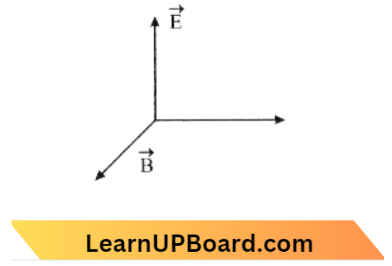
Question 17. The wavelength of light of frequency 100 Hz is:
- \(2 \times 10^6 \mathrm{~m}\)
- \(3 \times 10^6 \mathrm{~m}\)
- \(4 \times 10^6 \mathrm{~m}\)
- \(5 \times 10^6 \mathrm{~m}\)
Answer: 2. \(3 \times 10^6 \mathrm{~m}\)
We have, a relation between the velocity of light (c), frequency (v), and wavelength \((\lambda)\) is given by
c=v \(\lambda\)
Thus, wavelength,\(\lambda=\frac{c}{v}\)
Given, \(\mathrm{c}=3 \times 10^8 \mathrm{~m} / \mathrm{s}, v=100 \mathrm{~Hz}\)
∴ \(\lambda=\frac{3 \times 10^8}{100}=3 \times 10^6 \mathrm{~m}\)
Class 12 Electromagnetic Waves MCQs
Question 18. The frequency of the electromagnetic wave, which is best suited to observe a particle of radius 3 x \(10^{-4}\) cm, is of the order of:
- \(10^{15}\)
- \(10^{14}\)
- \(10^{13}\)
- \(10^{12}\)
Answer: 2. \(10^{14}\)
We have, \(\lambda=\frac{c}{v}\)
Here, \(\lambda=3 \times 10^{-4} \mathrm{~cm}\),
The velocity of light in a vacuum,
c =3 \(\times 10^{10} \mathrm{~cm} / \mathrm{s}\)
3 \(\times 10^{-4} =\frac{3 \times 10^{10}}{v}\)
Frequency of electromagnetic wave \(v=10^{14} \mathrm{~Hz}\)
Question 19. Match List-1 with List-2.
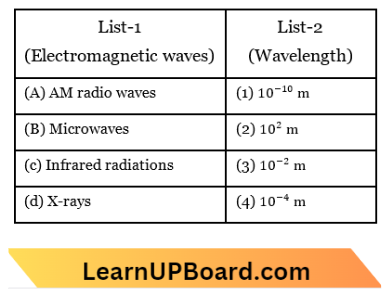
Choose the correct answer from the options given below.
- (A)-(4), (B)-(3), (C)-(2), (D)-(1)
- (A)-(3), (B)-(2), (C)-(1), (D)-(4)
- (A)-(3), (B)-(4), (C)-(2), (D)-(1)
- (A)-(2), (B)-(3), (C)-(4), (D)-(1)
Answer: 4. (A)-(2), (B)-(3), (C)-(4), (D)-(1)
The wavelength of AM radio waves is 102m. The wavelength of microwaves ranges between 10-3m to 10-1m. Infrared radiation wavelength lines Between 4 x 10-7m to 7 x 10-3m. X-ray wavelength ranges from 10-8 to 10-12 m.
Class 12 Electromagnetic Waves MCQs
Question 20. The electromagnetic wave with the shortest wavelength among the following is:
- UV-rays
- X-rays
- ϒ-rays
- Microwaves
Answer: 3. y-rays
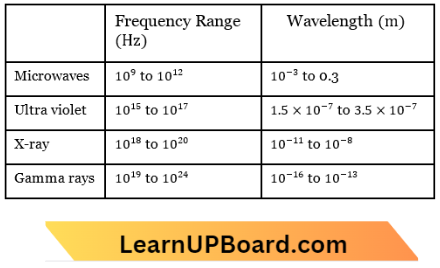
From the above table, it is clear that Gamma rays have the shortest wavelength and have a higher frequency than microwaves, X-rays, and UV rays.
Question 21. Three stars A, B, and C have surface temperatures TA, TB, and Tc, respectively. Star A appears bluish, star B appears reddish, and star C is yellowish. Hence;
- \(T_A>T_S>T_C\)
- \(T_B>T_C>T_A\)
- \(T_C>T_B>T_A\)
- \(T_A>T_C>T_B\)
Answer: 4. \(T_A>T_C>T_B\)
According to Wein’s displacement law:
⇒ \(\lambda \mathrm{T}\) =b
⇒ \(\lambda \propto \frac{1}{\mathrm{~T}}\) → Equation 1
From VIBGYOR we know,
⇒ \(\lambda_{\text {bluish }}<\lambda_{\text {yellowish }}<\lambda_{\text {reddish }}\)
\(\mathrm{T}_{\mathrm{A}}>\mathrm{T}_{\mathrm{C}}>\mathrm{T}_{\mathrm{B}}\) [using eq (1)]
Question 22. Which color of light has the longest wavelength?
- Blue
- Green
- Violet
- Red
Answer: 4. Red
∴ \(\lambda_{\text {red }}>\lambda_{\text {green }}>\lambda_{\text {blue }}>\lambda_{\text {red }}>\lambda_{\text {violet }}\)
Class 12 Electromagnetic Waves MCQs
Question 23. The energy of the EM waves is of the order of 15 keV. To which part of the spectrum does it belong?
- X-rays
- Infrared rays
- Ultraviolet rays
- y-rays
Answer: 1. X-rays
We know, E =\(\frac{h c}{\lambda} \)
⇒ \(\lambda_i =\frac{h c}{E}=\frac{6.62 \times 10^{-30} \times 3 \times 10^8}{15 \times 10^3 \times 1.0 \times 10^{-19}}\)
= 0.828 \(\times 10^{-10} \mathrm{~m}\)
⇒ \(\lambda\)=0.828 AA
Since the order of wavelength is between 10 \(\mathrm{~nm}\) and 0.001 \(\mathrm{~nm}\), it belongs to X-ray.
Question 24. The condition under which a microwave oven heats up a food item containing water molecules most efficiently is:
- the frequency of the microwave must match the resonant frequency of the water molecules
- the frequency of the microwave has no relation with the natural frequency of water molecules
- microwaves are heat waves, so always produce heating
- infrared waves produce heating in a microwave oven
Answer: 1. the frequency of the microwave must match the resonant frequency of the water molecules
It is an electromagnetic wave.
Important MCQs On Electromagnetic Waves
Question 25. The decreasing order of wavelength of infrared, microwave, ultraviolet, and gamma rays is:
- gamma rays, ultraviolet, infrared, microwaves
- microwaves gamma rays, infrared, ultraviolet
- infrared, microwaves ultraviolet, gamma rays
- microwave infrared, ultraviolet, and gamma rays
Answer: 4. microwave infrared, ultraviolet, gamma rays
Decreasing order of wavelength \((\lambda)\)
Microwave > Infrared > Ultraviolet > Gamma ray
Question 26. If \(\lambda_v, \lambda_x\) and \(\lambda_m\) represent the wavelength of visible light, X-rays and microwaves respectively, then:
- \(\lambda_m>\lambda_x>\lambda_v\)
- \(\lambda_m>\lambda_v>\lambda_x\)
- \(\lambda_v>\lambda_x>\lambda_m\)
- \(\lambda_v>\lambda_m>\lambda_x\)
Answer: 2. \(\lambda_m>\lambda_v>\lambda_x\)
⇒ \(\lambda_{\mathrm{m}}>\lambda_v>\lambda_x\)
In spectrum X-rays has minimum wavelength and microwave has maximum wavelength
Question 27. We consider the radiation emitted by the human body. Which one of the following statements is true?
- The radiation emitted is in the infrared region
- The radiation is emitted only during the day
- The radiation is emitted during the summers and absorbed during the winters
- The radiation emitted lies in the ultraviolet region and hence is not visible
Answer: 1. The radiation emitted is in the infrared region
Everybody at all times, at all temperatures emits radiation that falls in the infrared region.
Question 28. Which of the following rays are not electromagnetic waves?
- X-rays
- y-rays
- \(\beta\)-rays
- heat rays
Answer: 3. (3-rays
∴ \(\beta\)-rays are not electromagnetic waves.
Important MCQs On Electromagnetic Waves
Question 29. Which has a minimum wavelength?
- X-rays
- Ultraviolet rays
- y-rays
- Cosmic rays
Answer: 4. Cosmic rays
Cosmic rays have very short wavelengths.
Wavelengths →
X-ray → 1 Å to 100 Å
Ultraviolet rays → 100 Å to 1 Å
⇒ \(\gamma-\)ray s→ 0.001 Å to 1 Å
Cosmic rays \(\rightarrow\) upto 4 \(\times 10^{-3} \) Å
Question 30. Which of the following is the cause of the ‘Greenhouse effect’?
- Infrared rays
- Ultraviolet rays
- X-rays
- Radio waves
Answer: 1. Infrared rays
NEET Electromagnetic Waves Questions
Question 31. The frequency of y-rays, X-rays, and ultraviolet rays are a, b, and c respectively. Then,
- a > b > c
- a < b < c
- a = b = c
- a > c > b
Answer: 1. a > b > c
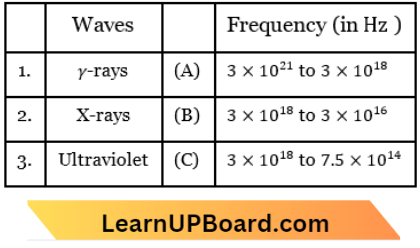
Question 32. The ozone layer blocks the radiations of wavelength:
- less than 3 \(\times 10^{-7} \mathrm{~m} \)
- equal to 3 \(\times 10^{-7} \mathrm{~m}\)
- more than 3 \(\times 10^{-7} \mathrm{~m}\)
- All of the above
Answer: 1. less than 3 \(\times 10^{-7} \mathrm{~m} \)
In the ozone sphere, the ozone layer extends from 30 km to nearly 50 km above the earth’s surface. This layer absorbs the majority of the sun’s UV radiation and prevents it from reaching the earth’s surface.
Since the range of UV radiations is 100 \(Å-4000 Å\). As a result, it absorbs radiations of wavelength of less than 3 x \(110^{-7}\)( or 3000 \(Å\)).
NEET Electromagnetic Waves Questions
Question 33. A signal emitted by an antenna from a certain point can be received at another point of the surface in the form of:
- sky waves
- ground waves
- sea wave
- Both 1 and 2
Answer: 4. Both 1 and 2
The transmitting, receiving, and processing of data over space is referred to as space communication.
The modes of space communication are listed below.
1. Round or surface wave propagation
2. Space wave or tropospheric wave propagation
3. Sky wave propagation
4. Satellite communication
Question 34. The structure of solids is investigated by using:
- cosmic rays
- X-rays
- γ-rays
- infrared radiations
Answer: 2. X-rays
X-rays are used to investigate the structure of solids because of their strong penetrating capacity. For this purpose, the lane spot method and rotating cylinder method are unsuitable. X-rays strike the solid under investigation, exposing its structure on a photographic plate.
Electromagnetic Spectrum MCQs
Question 35. Which of the following is the longest wave?
- X-rays
- γ-rays
- Microwaves
- Radiowaves
Answer: 4. Radiowaves
The following is a list of wavelength ranges of various waves.
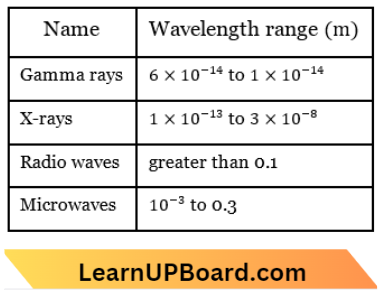
Clearly, radiowaves are the longest waves.
